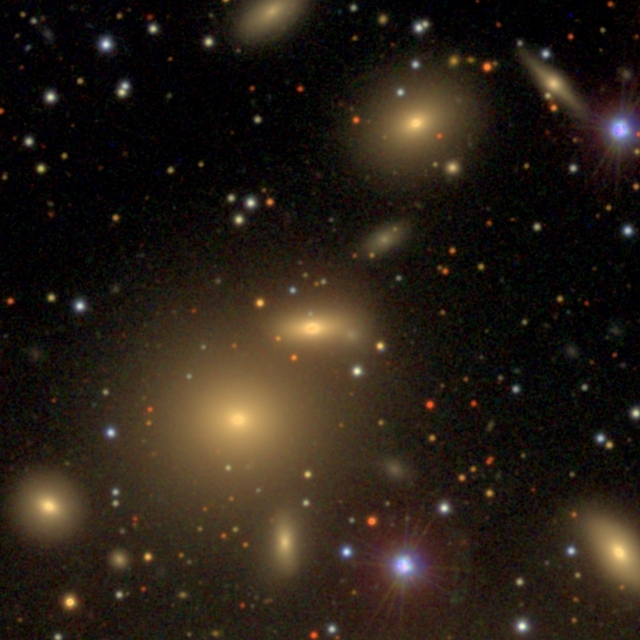
The supermassive black holes occupying the centers of most galaxies have a close relationship with their galactic hosts. Galaxies with large central bulges have massive black holes, while the relatively lightweight black holes live in galaxies with smaller bulges. This link has been observed in enough cases to raise it nearly to a principle: black holes and galactic bulges grow together, as part of a single process.
A new observation has revealed a galaxy that isn't just bending the rule, but completely breaking it. In most systems, the black hole's mass is about 0.1 percent of the mass of the galaxy's central bulge. Remco van den Bosch and colleagues identified a black hole with a mass that's about 59 percent of the mass of the central bulge. In fact, this black hole is one of the most massive ever observed, a striking discovery in a galaxy much smaller than our own. The galaxy itself is a bit on the small side, and the researchers suggest that we might want to look at the black holes in more galaxies this size.
Galaxies such as the Milky Way divide into three basic regions: disk, which contains the brightest and youngest stars, as well as the spiral arms; the bulge at center, which has older stars; and the halo surrounding the luminous portions. Nearly every galaxy appears to contain a supermassive black hole in its central bulge. Studies of a large number of galaxies have revealed a close relationship between the mass of the central black hole and the size of the galactic bulge.
The current study examined NGC 1277, a lenticular galaxy (meaning lens- or lentil-shaped, depending on proximity to lunchtime). Lenticular galaxies resemble spiral galaxies (the category including the Milky Way and our nearest large neighbor, Andromeda), but lack the spiral arm structure. NGC 1277 is relatively compact, with a total mass around 120 billion times that of the Sun, approximately 1/10 the Milky Way's mass. Additionally, NGC 1277 lacks a significant bulge; the published paper made reference to a "pseudo-bulge" due to the lack of well-defined bulge characteristics.

Measuring the mass of a black hole typically requires measuring the spectrum of gas and stars in the central regions and obtaining a good image of the galaxy. To this end, the researchers used the 11-meter Hobby-Eberly Telescope (HET) in Texas, an instrument suited to high-resolution spectral imaging. They measured the motion of material near the centers of 700 galaxies, and discovered six—including NGC 1277—with stars that were moving much faster than expected. This indicates that something massive is accelerating the gas and stars beyond the speeds typical in similar galaxies. The observations also revealed that more of each galaxy's mass was concentrated in its central region than expected.
Of the six studied, only NGC 1277 was also the subject of a high-resolution image, taken using the Hubble Space Telescope. The researchers used the available data to obtain the most likely values for several galactic parameters, including the bulge mass and the black hole mass. They found the central black hole most likely had a mass between 14 billion and 20 billion times the Sun's—significantly larger than most previously observed black holes in any galaxy. Given it's in a relatively small galaxy, the black hole appeared amazingly out of proportion: 59 percent of the estimated bulge mass, and 14 percent of the total mass of NGC 1277.
Since supermassive black holes are typically proportional to the bulge mass, these results were striking. NGC 1277 contains many old stars, and shows no signs of being heavily distorted by interactions with other galaxies. This means NGC 1277 is unlikely to have been the remnants of a much larger galaxy, ruling out the possibility that the black hole and galaxy grew normally before some of the galaxy's stars were stripped.
The existence of five more compact galaxies with rapidly moving matter in the central regions could suggest that disproportionately oversized black holes are not unique to NGC 1277. Further observations should settle that question.
Why should such a huge black hole live in such a small galaxy? The astronomers (probably wisely) remained silent on this question, since the clear data come from only one sample. But whether outsized black holes reside in many compact lenticular galaxies or just in NGC 1277, we'd still need to explain how the usual, well-established relationship between black hole and bulge masses could be violated so dramatically.
(The author wishes to acknowledge that a lot of sophomoric dirty jokes will be made about the terminology in this article. He has thought of them all, so there is no need to leave them in the comments section.)
Nature, 2012. DOI: 10.1038/nature11592 (About DOIs).
reader comments
46